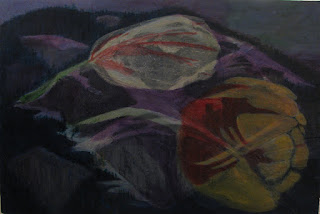One of the most moving paintings I know is Camille Pissarro's "The Banks of the Marne in Winter." I came late to an appreciation of Pissarro the painter although I'd always liked what I'd read of Pissarro the person -- his doggedness in pursuing his art in the face of grinding poverty, the unfailing encouragement he extended to other artists, his warmth for his family (even if he couldn't feed them properly).
As I began to look at reproductions of his paintings in recent years, "The Banks of the Marne in Winter" struck me with all the force of his writings and biographies -- please view it via this link although the small digital reproduction is scarcely adequate. If there is any question about whether painted landscapes can convey feeling, this painting to me is the answer.
I made a study of its tones:
...and whenever I see this simple reminder in my sketchbook, it evokes Pissarro's story and, through it, the painful lives of the rural poor in 19th century France, the exhaustion of never-ending physical labour, the daily effort to put food on the table, Pissarro's family's constant relocation from one cheap inadequate cottage to another where -- credits to Mme. Pissarro -- he was enabled to continue to paint. There's a feeling in this painting of loneliness and desolation but also of determination and endurance.
Far removed from that time and experience, I've found myself as I age to be more and more affected by dark winter and its depths. In the last few years, I've tried to plan a "depths of winter" painting to shine a little light in the darkness. This year, before we'd even hit the depths, there was a convergence: I noticed my old sketchbook study. Then one of my upside-down photos caught my eye in a certain way:
...and I was reminded of another river -- the Squamish, whose banks we used to observe in every season as we drove to and from our cabin. I made a rough drawing of these river bank memories, in a layout suggested by the upside-down photo.
Then I faced the fact that I'm still without a stash of artists' paper, and I hauled out an old but large (24" x 36") panel (pressed board "cradled"/stabilized with cross bars on the back) that had seen two false starts on a collaged surface -- one (horizontal) a view of Cloudburst Mountain, just above our cabin; the other (vertical) some Rembrandt tulips.
I grabbed some tissue paper that had just arrived, wrapped around mandarin oranges, and began to develop the base layers of "The Banks of the Squamish in Winter." You can view its progress here --and see how the underlying collage of the earlier false starts presented a problem that eventually was solved (or not?) with the addition of a patch of salmonberry bushes in centre stage.
Here's the final outcome:
The solitude of these Squamish river banks has less to do with humankind than with vast nature verging on wilderness. Old stumps remain from early 20th century logging days, and one doesn't have to travel far up the river to see new depredations -- accelerated logging practices and "run of river" power stations. But our stretch of the river was marked in winter by deep slow water, eagles overhead or feeding on the shoals, and the occasional call of ravens -- an "aloneness" rather than a "loneliness."
Reviewing my goals: Have I done "my best painting yet"? -- not by a long shot, I'm afraid. In fact, I have a hunch that this panel is destined to be reinvented again some day when I'm short of paper. For now, though, I've immersed myself in the depths and come through feeling heartened by memories of winters past.







Fascinating to observe how you work, Kelly. I love the texture and colors of this but feel it's an "almost" painting because of the placement of the clump of salmonberries. I think they catch your eye too strongly in their centered location, breaking up the beautiful, icy blue flow of the water. Perhaps some additional, somewhat smaller extension of the clump "flowing" along to the left?? Again, the colors and textures are wonderful, and the painting conveys the solitude and "aloneness" extremely well.
ReplyDelete